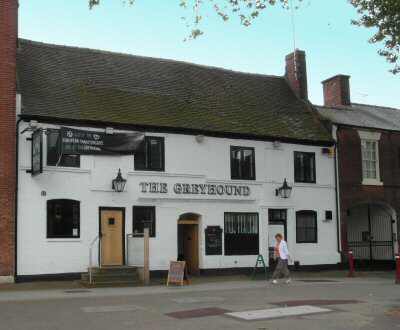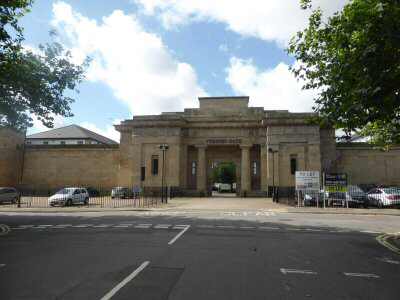WESTERN DERBY TRAIL - UPPER FRIAR GATE
TRAIL 3 – UPPER FRIAR GATE
Looking up Friar Gate
This trail covers Upper Friar Gate from the Railway Bridge to the area where cattle markets were held until 1861. It has many interesting buildings though it is best known for its fine Georgian buildings, which line the main street.

Friar Gate was the first Conservation Area in Derby; it was designated in September 1969 and has been extended several times. It takes its name from the 13th-century Friary that once stood by the road in the lower part of Friar Gate. It was the executions that people flocked to the area to see during the 18th and 19th centuries when the ritual procedures introduced by the Tudors became seen as entertainment for the masses.
The executions outside the gaol at the bottom of Vernon Street attracted sideshows, pedlars, acrobats and other entertainers. People even came by train for what some regarded as a good ‘day out’. Local traders selling souvenirs did a roaring trade; there were even gingerbread effigies of the prisoner to be executed. The viler the crime and notorious the prisoner, the larger the crowds.
Some executions attracted crowds of 20,000 to 40,000 people, nowadays it is football that regularly draws the big crowds to Derby. Pickford’s House at 41 Friar Gate is a handsome Grade I listed building, built in 1769 by Derby architect Joseph Pickford, for his occupation. He was born in Warwick in 1734 and was the son of a stonemason. At 14, he was apprenticed to his uncle, who was also a stonemason. After working on Horse Guards Parade in Whitehall and several other projects with his uncle, he became involved in 1759, with work at Foremark Hall in Derbyshire. Three years later he married and set up a home in Derby and attracted several notable patrons, the Duke of Devonshire the foremost. His most noteworthy achievement in Derby was designing St Helen’s House.
Derby’s Crest on Friar Gate Bridge

The Borough crest or common seal of Derby, the Buck in the Park, is displayed on Friar Gate Bridge as part of the ornamentation. It depicts a deer, in the shape of a buck in a fenced park. Deer were in plentiful supply in Derbyshire when the Danish invaders named their first fort after the wild deer that were so abundant in the area. However, the crest was only officially sanctioned as a Coat of Arms in 1939. Apart from deer, sheep were the backbone of farming in the past and the ram is the county’s regimental mascot.
Friargate Railway Bridge
It is two bridges side by side, set at a slight angle to each other where the tracks diverged, to embrace the island platform of Derby Friargate Station (in this context ‘Friargate’ was always spelt as one word) on the southern side. As the tracks were above the road, the Great Northern Railway Station was entered from below, and access was gained to the four platforms via a tunnel and steps. Handysides built the bridge, a local Derby company and the first train left the station on 1 April 1878 and the last on 5 May 1964. The final goods train passed through on 4 May 1968.
The Great Northern Railway Company had Friar Gate Bridge constructed in 1878, despite very strong opposition. Local people were in uproar saying that the bridge would destroy the appearance of what they termed ‘the best street in Derby,’ anger only equivalent to that a century later when it was suggested the bridge should be removed. The bridge was made deliberately ornate to try to match the handsome Georgian street below and placate the protesters

The Great Northern Railway Company line passed through the heart of the town. The property had to be demolished and residents uprooted, bridges built, cuttings, embankments and a long viaduct constructed. Despite strong opposition, the GNR managed to get Parliament to pass an act to give them the go-ahead in July 1872. They argued that the houses to be demolished were of poor quality and needed to be replaced, but the main reason people lived in the area was that they were poor and there were few other alternatives. A total of around 265 houses were destroyed. Cherry, Short and Baxter streets were demolished’ entirely, and Granville and South Street were shortened.
Pickford’s House

Pickford’s most notable achievements in Derby were the building of St Helen’s House and his building work in Friar Gate, which was not just confined to the house he built for himself and his family. Designated in September 1969 and subsequently added to on several occasions, Friar Gate was Derby’s first Conservation Area. It has many interesting buildings, over 100 of which are listed as Buildings of Special Architectural or Historic Interest. Although it is best known for its fine Georgian buildings, there are also several late Georgian and Regency buildings along Ashbourne Road, which are included in the Conservation Area.
Number 41, Friar Gate was built by Joseph Pickford between 1769 and 1770 for his occupation. The façade was designed to impress clients who might well only see the front of the house. For those who entered the premises, they would find the hall richly decorated with ornamental plasterwork and the house’s finest room, the saloon, where they would probably be entertained, was entered by a door opposite the entrance. His builder’s yard and stonemason’s workshops were at the rear of the house. In 1988, the house was converted into a museum and opened to the public.
Electrical transformer kiosk

This kiosk is somewhat of a mystery item for many passers-by who wonder what purpose it serves. It is actually an electrical transformer box and was manufactured by Walter MacFarlane and Company of the Saracen Foundry, Glasgow, and formed part of Derby’s original electrical lighting scheme of 1893 and is now preserved in situ. The kiosk has the ‘Buck in the Park’ emblem on the side. Now Derby’s coat of arms, ‘the Buck in the Park’ first appeared on a medieval seal in 1446.
Another surprise for many passersby is that the telephone kiosk by Friar Gate Bridge, known as K6, is Grade II listed. It was designed by the famous architect Sir Giles Gilbert Scott, the grandson of Sir George Gilbert Scott, who won a competition in 1935 for the design of telephone kiosks.
Former Royal Institution for the Deaf and Dumb
To the rear of the electrical transformer, where the Royal Institution for the Deaf and Dumb used to stand are cast-iron slabs embedded in the pavement, illustrating ‘Signing’ Hands, the signals used to communicate by teachers and pupils. The slabs were created as part of a community programme with the Royal School for the Deaf and Dumb to commemorate the school.

The Elementary Education Act of 1870 made free education available and all children under 12 were expected to attend school. This resulted in several Board Schools being opened in Derby. Deaf and dumb children were also catered for when William Roe at the age of 20, spent much of his spare time teaching uneducated deaf adults at his father’s house. His reputation as a teacher of the deaf grew and his vocation became so time-consuming that he started to work on a full-time basis.
In 1880, he, along with the Derbyshire Association for the Deaf, began raising funds to build a dedicated institution in Derby. A site was acquired on Friar Gate and the building was completed in 1894. The ‘Royal’ title was added after Queen Victoria’s visit in her Diamond Jubilee year. In 1972 the school relocated to a site further out of town on Ashbourne Road and shortly afterwards the Friar Gate premises were demolished

Stoneware Sculpture
Near the front of the former Large’s Hospital is a collection of stoneware heads, planted at the base of London plane trees which have graced this elegant Georgian Street since the 1860s. The heads are intended to represent the figures in the crowds that gathered in Derby at the time of the Reform Bill of 1831 when a considerable amount of rioting took place in the town. They were designed by Timothy Clapcott and installed in 2000 by the Sustrans cycle network and are certainly worth close inspection.
When the Reform Bill was first heard in Parliament only 5% of the population of England, Scotland and Wales had the right to vote, which was considered by many as unjust. There were constituencies with only a few voters who had two MPs and others much larger with none. Ballots were not secret and as a result, candidates bought votes usually through the provision of free beer. The bill was passed by the House of Commons but thrown out by the House of Lords. Rioting followed with serious disturbances in many places, including Derby. This resulted in the passing of the Reform Bill the following year.
Former Large’s Hospital

Large’s Hospital, founded by Edward Large of Derby in 1709, for five clergymen’s widows with a small court in front and a garden at the rear divided amongst the inhabitants. The almshouses known as Large’s Hospital were rebuilt in 1880 for the benefit of the clergy widows. The buildings have now been converted into offices.
The panels on the building have aged and become difficult to read, but what they appear to say is as follows. One says “In Memory of Edward Large of Derby Gent, who by his Will ordered John Curzon of Kedleston, Robert Wilmot the younger of Osmaston and Robert Holden of Aston in the county of Derby, Esquires as trustees to erect this Edifice to Support of Five Poor Parsons or Vicars Widows forever. 1716.” The other reads “This edifice known as Large’s Hospital was rebuilt AD 1880 by his Trustees viz, Sir Henry Wilmot of Chaddesden Hall, Bar V.C. Albert Frederick Hurt, of Alderwasley, Esq Francis Noel Mundy, of Markeaton Hall, Esq Godfrey Franceys Meynell of Meynell Langley Esq Henry Boden of The Friary, Derby. Esq Walter Evans of Darley Abbey, Esq and Edward Miller Mundy, of Shipley Hall, Esq.”
Friar Gate County Gaol
The gaol in Friar Gate, at that time known as Nuns Green, was opened in 1756. Before this, the town prison had been located at the end of the Corn Market, on a bridge over Markeaton Brook. Although the gaoler’s accommodation was at street level, the cells were in the basement. Markeaton Brook was also the town’s main sewer and, inevitably the gaol suffered from the horrible stench. As a result, many prisoners died from disease and flooding.

The Corn Market Gaol survived for almost 200 years, until, following numerous complaints, it was decided to build a more substantial structure away from the town centre. At a meeting in 1755, an agreement was reached to relocate the gaol outside the centre of Derby and a site at Nuns Green (now Friar Gate) was chosen. This was one of the traditional execution places for criminals and it appeared an ideal spot for a more substantial gaol to be built. In 1756, the Corn Market gaol was finally closed and the new gaol had its first complement of prisoners. Designed to house a maximum of 29 prisoners, it was soon obvious that it was too small, but it was some years before another prison was built.
The gaol is now a working museum which is open to the public having been acquired in 1997 by Richard Felix, paranormal investigator and dedicated historian. It was restored as far as possible to replicate its original state. Currently, it has two cells: The Condemned Cell and the Debtor’s Cell. Each one features the original doors which have been re-hung, complete with the prisoners’ original ‘graffiti’… names, dates and day markers, etched into the wood, marking down how many days the prisoner had until execution. A twenty-four-hour investigation in Derby by the TV’s Most Haunted team brought both the gaol and the city to the attention of a wider audience and has resulted in it becoming a popular venue for ghost hunters. The public entrance is off Agard Street, opposite the Golden Eagle public house.
The Greyhound Inn

The name of this late 17th-century pub pre-dates the former Greyhound Stadium that used to operate in nearby Vernon Street, from where many people mistakenly think it takes its name. The greyhound was a badge of Edward IV and, by inheritance the Tudor Monarchs and also the crest of two well-known Derbyshire families, the Blackwalls and Gells. Originally thatched, the pub no longer owns the former carriage arch and adjacent buildings.
During the period when cotton spinning was an important cottage industry, the landlord, Joshua Simmonds, sold stocking frames. The pub is now, one of only two remaining pubs that once served the animal markets that were held at the end of Friar Gate. Following closure in 2008, it was reopened by a well-known firm of Derby brewers two years later.
Former County Gaol (Derby Prison) Vernon Street

Derby did not have its own gaol until the Corn Market Gaol was built, over Markeaton Brook in the centre of the town. Before that Derbyshire’s criminals were sent to prison at Nottingham Castle. Following the part demolition of Derby’s Vernon Street Prison in 1919, convicted prisoners were once again sent to Nottingham. The Friar Gate Gaol opened in 1756 and, quickly proved to be too small, but nothing was done about it at the time. Eventually, another gaol was built between 1823 and 1827 at the end of Vernon Street, designed by Francis Goodwin. At that time, it was claimed to be “One of the most complete prisons in England.” Following the Reform Act riots, it was strengthened and fortified with Martello Towers designed by John Mason of Derby. It was remodelled again in 1880 and changed its name to HM Prison Derby in 1886. In 1919, part of the gaol was demolished, with what was left overused as a military prison. However, in 1928 the prison was completely demolished, leaving only the Curtain Wall and the imposing entrance. In 1933, the Preston Greyhound Association converted it into a Greyhound Stadium, but this closed in 1988 and the land was sold. Following the closure of the stadium, it was redeveloped in 1996 for mixed accommodation and business use.
Headless Cross
At the top end of Friar Gate, a Headless Cross without a shaft and of medieval origin has been positioned close to the side of the road. In 1792, the Third Improvement Commission saw the cross transferred to Joseph Strutt’s home at Thorntree House, St Peter’s Street and it was kept in his garden as an ornament. It stayed there until Strutt had the Arboretum constructed, it was then moved there together with several other garden ornaments.
In 1981, the cross was moved back to its present location in Friar Gate. It is said that it was once a complete cross, but that it lost its head long before the battle of Agincourt. During outbreaks of the plague, all public gatherings were discontinued. Foodstuffs were left near the cross by local farmers, who would vigorously chew tobacco while depositing their produce, as this was considered to act as a preventative action against the disease. The hollow in the top of the stone was filled with vinegar, which acted as a form of disinfectant for the coins that were immersed by the starving citizens of Derby, in payment for food.

